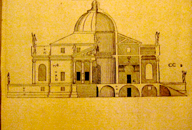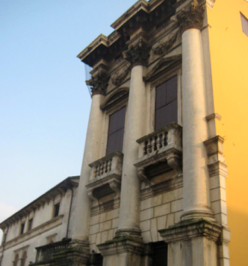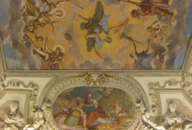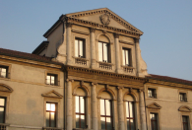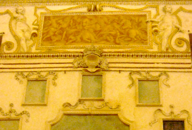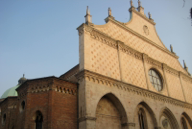andrea palladio
Palazzo Barbara da Porto
vicenza, the veneto
northern italy
Europe
november 7-10, 2008


andrea palladio
Palazzo Barbara da Porto
vicenza, the veneto
northern italy
Europe
november 7-10, 2008




Upon our arrival in Vicenza, Henry and I both felt so fortunate to find an exhibition entitled “500 Years” celebrating the architect, Andrea Palladio (1508-1580), in the Palazzo Barbara da Porto. The exhibition was conceived to be a story set in ten rooms of the most beautiful Palladian palazzo, “to tell the story of a boy of humble background who started as a stone mason and became the most famous architect in the world.” He did so with conviction, that “architecture can improve the world around us”. The exhibition was organized by Centro Internationale di Studi di Architettura Andrea Palladio, the Royal Academy of Arts, London, in collaboration with the Royal Institute of British Architects. The exhibition was designed to take the visitor on a journey through time, by presenting material, paintings, drawings and models so that we, the viewer, could perceive the life and times of this great architect through the eyes of his patrons, friends, and rivals. Included in this exhibition were paintings by Tintoretto and Paolo Veronese, a portrait of Andrea Palladio by El Greco, plus paintings by Canaletto and Zuccarelli which included Palladian architecture, an 18th century style which emphasized the esteem to which English collectors held his work. Drawings by Palladio, some of which have been in collections in Great Britain for four hundred years, showed his working methods and the planning stages for his buildings. One of the design principles revealed in this exhibition, was his division of the circle into four equilateral parts. This principle expressed the regularity and the potential variations, which were echoed in the solidity, order, and classicism of his architecture, Three-dimensional models of many of his palazzi and villas brought Palladio’s drawings to life, enabling us to more fully understand how he worked through landscape challenges, urban planning limitations, and even his patrons’ financial problems, to achieve buildings which would satisfy his four criteria, adapted from Vitruvius: beauty, splendor, proportion, and practicality.
The amazing life of Palladio,, born Andrea di Pietro della Gondola in Padua, was apprenticed as a stonecutter at the age of 13. He broke his six-year contract after only 18 months, fleeing to Vicenza, where he became an assistant to a leading workshop of stonecutters and masons. Frequenting the workshop of Bartholomeo Cavazza, he learned his skills. By his early 30’s, his talents were recognized by Count Gian Giorgio Trissino, who employed him on a building project. This patron gave him the name Palladio, based on the name Pallas Athene, a goddess whose image graced the Parthenon. Later, Daniele Barbaro and his brother Marcantonio became patrons, and the elder, Daniele, encouraged Palladio’s studies in Rome. It was here that Palladio studied the classical Roman architecture, principally Vitruvius. He was influenced by his writings, and in 1570 published I Quattro Libri dell’Architecttura (The Four Books of Architecture). Because of this, his influence was far reaching as his ideas about architecture were spread beyond the Veneto. Palladio was a man of his time, whose major commissions were of three types of buildings: the urban palazzo, the country villa, and the church. His understanding of social order, in both sacred and secular circles, allowed him to express social standing while delivering architectural designs of extraordinary aesthetic quality. He reinforced social hierarchy through the concept of the piano nobile in his urban palazzi. His country villas organized a diverse architectural scheme of separate buildings into an organized grand villa consisting of raised central block, flanked by lower service wings. He also created a new architecture in the Roman Catholic church which expressed the concept of two worlds, divine and earthly, existing simultaneously. His two interlocking orders, one superior, one inferior concretely communicated the idea of the two superimposed systems. All of Europe was influenced by Palladian architecture, especially evident in buildings in Great Britain by Inigo Jones, Christopher Wren, Lord Burlington (Chiswick House), and William Kent In America, Thomas Jefferson’s Monticello, the University of Virginia, Pope’s National Gallery c. 1940, plus many courthouses and government buildings throughout the country, are among the examples of Palladian influence. Palladio, and his “teacher” Vitruvius remain an influence today, even among contemporary architects.
PHOTOS: Left Column: 1. Drawing, Villa Valmarana. 2. Plan of Villa Valmarana. 3. Ceiling frescoes, Palazzo Barbara da Porto, Vicenza. 4. Palladian palazzo in Vicenza. Center, Top; Sculptural portrait of Andrea Palladio standing before the Palazzo della Ragione Loggias which he designed in Piazza di Signori, Vicenza. Center, Bottom: A Palladian project commissioned by his friend, who ran out of money. Palladio finished the project, much smaller than anticipated, however, maintaining great classical style. Right Column: 1. Drawing, Villa Rotunda. 2. Plan, Villa Rotunda. 3. Wall frescoes and decorations above the fireplace, Palazzo Barbara da Porto, Vicenza. 4. Il Duomo di Vicenza by Palladio.

Exhibition at Palazzo Barbara
